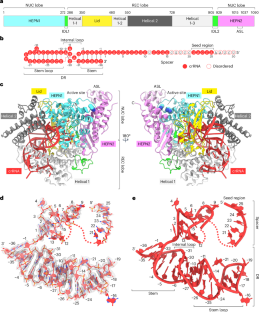2025-04-14 韓国基礎科学研究院(IBS)
<関連情報>
- https://ibs.re.kr/cop/bbs/BBSMSTR_000000000738/selectBoardArticle.do?nttId=25775&pageIndex=1&searchCnd=&searchWrd=
- https://molecularneurodegeneration.biomedcentral.com/articles/10.1186/s13024-024-00788-8
- https://molecularneurodegeneration.biomedcentral.com/articles/10.1186/s13024-024-00740-w
- https://medibio.tiisys.com/99009/
アルツハイマー病における星細胞性GABA産生に重要な酵素としてのSIRT2とALDH1A1 SIRT2 and ALDH1A1 as critical enzymes for astrocytic GABA production in Alzheimer’s disease
Mridula Bhalla,Jinhyeong Joo,Daeun Kim,Jeong Im Shin,Yongmin Mason Park,Yeon Ha Ju,Uiyeol Park,Seonguk Yoo,Seung Jae Hyeon,Hyunbeom Lee,Junghee Lee,Hoon Ryu & C. Justin Lee
Molecular Neurodegeneration Published:15 January 2025
DOI:https://doi.org/10.1186/s13024-024-00788-8
Graphical Abstract

Abstract
Background
Alzheimer’s Disease (AD) is a neurodegenerative disease with drastically altered astrocytic metabolism. Astrocytic GABA and H2O2 are associated with memory impairment in AD and synthesized through the Monoamine Oxidase B (MAOB)-mediated multi-step degradation of putrescine. However, the enzymes downstream to MAOB in this pathway remain unidentified.
Methods
Using transcriptomics analysis, we identified two candidate enzymes, Aldehyde Dehydrogenase 1 family member A1 (ALDH1A1) and Sirtuin 2 (SIRT2) for the steps following MAOB in the astrocytic GABA production pathway. We used immunostaining, metabolite analysis and electrophysiology, both in vitro and in vivo, to confirm the participation of these enzymes in astrocytic GABA production. We checked for the presence of SIRT2 in human AD patients as well as the mouse model APP/PS1 and finally, we selectively ablated SIRT2 in the astrocytes of APP/PS1 mice to observe its effects on pathology.
Results
Immunostaining, metabolite analysis, and electrophysiology recapitulated the participation of ALDH1A1 and SIRT2 in GABA production. Inhibition of SIRT2 reduced the production of astrocytic GABA but not H2O2, a key molecule in neurodegeneration. Elevated expression of these enzymes was found in hippocampal astrocytes of AD patients and APP/PS1 mice. Astrocyte-specific gene-silencing of SIRT2 in APP/PS1 mice restored GABA production and partially improved memory function.
Conclusions
Our study is the first to identify the specific role of SIRT2 in reactive astrogliosis and determine the specific pathway and metabolic step catalyzed by the enzyme. We determine the partial, yet significant role of ALDH1A1 in this process, thereby highlighting 2 new players the astrocytic GABA production pathway. Our findings therefore, offer SIRT2 as a new tool to segregate GABA from H2O2 production, aiding future research in neurodegenerative diseases.
アルツハイマー病におけるアストロサイトのオートファジー可塑性がAβクリアランスと認知機能を調節する Astrocytic autophagy plasticity modulates Aβ clearance and cognitive function in Alzheimer’s disease
Suhyun Kim,Heejung Chun,Yunha Kim,Yeyun Kim,Uiyeol Park,Jiyeon Chu,Mridula Bhalla,Seung-Hye Choi,Ali Yousefian-Jazi,Sojung Kim,Seung Jae Hyeon,Seungchan Kim,Yeonseo Kim,Yeon Ha Ju,Seung Eun Lee,Hyunbeom Lee,Kyungeun Lee,Soo-Jin Oh,Eun Mi Hwang,Junghee Lee,C. Justin Lee &Hoon Ryu
Molecular Neurodegeneration Published:23 July 2024
DOI:https://doi.org/10.1186/s13024-024-00740-w

Abstract
Background
Astrocytes, one of the most resilient cells in the brain, transform into reactive astrocytes in response to toxic proteins such as amyloid beta (Aβ) in Alzheimer’s disease (AD). However, reactive astrocyte-mediated non-cell autonomous neuropathological mechanism is not fully understood yet. We aimed our study to find out whether Aβ-induced proteotoxic stress affects the expression of autophagy genes and the modulation of autophagic flux in astrocytes, and if yes, how Aβ-induced autophagy-associated genes are involved Aβ clearance in astrocytes of animal model of AD.
Methods
Whole RNA sequencing (RNA-seq) was performed to detect gene expression patterns in Aβ-treated human astrocytes in a time-dependent manner. To verify the role of astrocytic autophagy in an AD mouse model, we developed AAVs expressing shRNAs for MAP1LC3B/LC3B (LC3B) and Sequestosome1 (SQSTM1) based on AAV-R-CREon vector, which is a Cre recombinase-dependent gene-silencing system. Also, the effect of astrocyte-specific overexpression of LC3B on the neuropathology in AD (APP/PS1) mice was determined. Neuropathological alterations of AD mice with astrocytic autophagy dysfunction were observed by confocal microscopy and transmission electron microscope (TEM). Behavioral changes of mice were examined through novel object recognition test (NOR) and novel object place recognition test (NOPR).
Results
Here, we show that astrocytes, unlike neurons, undergo plastic changes in autophagic processes to remove Aβ. Aβ transiently induces expression of LC3B gene and turns on a prolonged transcription of SQSTM1 gene. The Aβ-induced astrocytic autophagy accelerates urea cycle and putrescine degradation pathway. Pharmacological inhibition of autophagy exacerbates mitochondrial dysfunction and oxidative stress in astrocytes. Astrocyte-specific knockdown of LC3B and SQSTM1 significantly increases Aβ plaque formation and GFAP-positive astrocytes in APP/PS1 mice, along with a significant reduction of neuronal marker and cognitive function. In contrast, astrocyte-specific overexpression of LC3B reduced Aβ aggregates in the brain of APP/PS1 mice. An increase of LC3B and SQSTM1 protein is found in astrocytes of the hippocampus in AD patients.
Conclusions
Taken together, our data indicates that Aβ-induced astrocytic autophagic plasticity is an important cellular event to modulate Aβ clearance and maintain cognitive function in AD mice.


